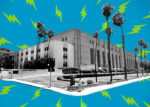Home developers stymied by regulations in California are roaring through a legal loophole known as the builder’s remedy – with cities and slow-growth groups preparing to push back.
Developers employed the little-known legal tactic this fall for thousands of apartments planned in Santa Monica and Redondo Beach after the cities failed to produce housing plans required by the state, the Los Angeles Times reported.
Now the builder’s remedy has become an option for developers in cities and counties statewide, including 124 in Southern California, that failed to meet a state deadline to plan for more homes. Cities in the Bay Area face a similar deadline on Jan. 31.
The pending construction boom stems from a provision in the decades-old Housing Accountability Act to spur construction by imposing a penalty if cities fail to pass “housing element” plans that comply with state housing goals.
Under the law, cities deemed noncompliant lose the authority to approve or deny projects with affordable housing components – which are automatically approved.
Developers can essentially propose building whatever they want, as long as they provide a percentage of affordable homes for low- or middle-income families.
In Santa Monica, WSC Communities, a development firm founded by Neil Shekhter and Scott Walter, used the builder’s remedy to greenlight 4,500 apartments – more than the city has built in a decade. Of 16 developments, including two from other builders, more than 900 units would be affordable.
In Redondo Beach, Next Century Power, a development firm founded by Leo Pustilnikov, used the legally untested tactic to pave the way for nearly 2,300 homes atop a former beachside power plant. Of those, more than 450 units would be affordable.
The builder’s remedy plans have stunned local elected officials, with some worrying that beachfront communities will lose their distinctiveness.
Santa Monica Councilmember Phil Brock called a 15-story highrise proposed by WSC as “beyond the pale” and an “unacceptable bar for the rest of the city.” He expects he and the City Council will try to block at least some of the projects.
“Some of this growth will be destructive to the idea that Santa Monica somewhere along the line was supposed to be a beachside town,” Brock told the Times. “As we blend into L.A., we’ll lose that character.”
One sticking point for the builder’s remedy projects could be the California Environmental Quality Act, which could require a lengthy review of environmental effects and open the door to litigation.
A slow-growth group, Santa Monica Coalition for a Livable City, is urging the City Council to consider filing a lawsuit to stop the projects.
“To say residents and council members are deeply concerned about this developer ambush and have questions that must be answered is an understatement,” the group said in a statement.
Because the builder’s remedy is untested in court, legal questions remain over what developments qualify, said Chris Elmendorf, a law professor at UC Davis who has researched the builder’s remedy loophole.
Because developers must dedicate at least 20 percent of units for low-income families or 100 percent for middle-income ones, the projects could be infeasible in less expensive areas with lower profit margins, he said.
Because of these uncertainties, Elmendorf doesn’t expect the builder’s remedy to lead to a massive surge in housing construction across the state. “The only places where this is a real threat is where development is super expensive,” he said.
In the Bay Area, the builder’s remedy workaround for developers could be duplicated in San Francisco, Berkeley, Oakland and San Jose, which each risk missing the Jan. 31 housing element deadline.
Santa Monica could be a bellwether for the Bay Area, Elmendorf told the San Francisco Business Times. “One scenario that seems quite plausible is that there will be a ton of these projects filed” if Bay Area cities fail to meet the deadline, he said.
— Dana Bartholomew
Read more


